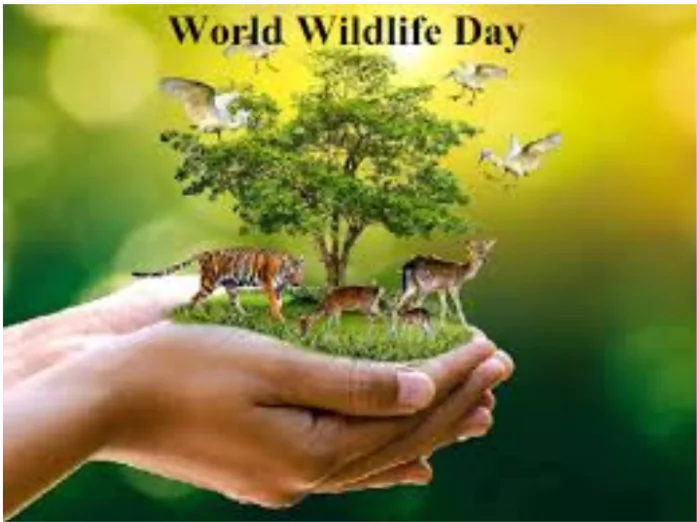Recently, World Wildlife Conservation Day was celebrated.
About World Wildlife Conservation Day

- It is celebrated on the 4th of December every year.
- Purpose: to raise awareness of conservation issues including poaching, over commercialisation, and global wildlife tracking.
- Theme 2024: Connecting People and Planet: Exploring Digital Innovation in Wildlife Conservation,”
India’s Biodiversity status
- India covers only 2.4% of the world’s land area but accounts for:
- 7-8% of all recorded species, including:
- 45,000 plant species.
- 91,000 animal species.
- Recognized as a megadiverse country due to its rich biodiversity.
Enroll now for UPSC Online Classes
- India has 10 biogeographic zones –
- 8.58% of mammalian species
- 13.66% of bird species
- 7.91% of reptiles
- 4.66% of amphibians
- 11.72% of fish
- 11.8% of plants
- Four global biodiversity hotspots in India:
- Himalayas.
- Indo-Burma.
- Western Ghats-Sri Lanka.
- Sundaland.
Species at Risk
- Critically Endangered Species in India
- India has 73 critically endangered species (as of 2022).
- IUCN classification: Critically endangered species are at the highest risk of extinction in the wild.
- Increase in numbers since 2011 (47 species) due to:
- Better data collection and monitoring.
- Habitat destruction and other threats.
- Endemic Species Under Threat
- Nine critically endangered mammals, including eight endemic species:
- Kashmir stag (Hangul).
- Malabar large-spotted civet.
- Andaman shrew.
- Jenkin’s shrew.
- Nicobar shrew.
- Namdapha flying squirrel.
- Large rock rat.
- Leafletted leaf-nosed bat.
 Underappreciated Species at Risk
Underappreciated Species at Risk-
- Large carnivores like lions, tigers, and cheetahs often overshadow other endangered species due to their tourism appeal.
- Birds like the Great Indian Bustard face severe threats, such as:
- Collisions with powerlines in Rajasthan.
Factors Behind Extinction of Species
- Habitat Loss: Urbanization and deforestation destroy natural habitats.
- Species Relocation: Moving species from their natural habitat disrupts ecological balance.
- Global Pollution: Pollution degrades ecosystems, affecting species survival.
- Climate Change: Rapid environmental changes threaten species that cannot adapt.
- Illegal Wildlife Trade: Unsustainable exploitation of species pushes them toward extinction and spreads zoonotic diseases.
India’s Domestic Legal Framework for Wildlife Conservation
Constitutional Provisions for Wildlife
- 42nd Amendment Act 1976: Added “Forests” and “protection of wild animals and birds” to the Concurrent List.
- Article 51 A (g): Fundamental duty of every citizen to protect and improve the natural environment, including forests and wildlife.
- Article 48 A: Mandates the State to protect and improve the environment and safeguard forests and wildlife.
Legal Framework
- Wildlife (Protection) Act, 1972: Provides the legal framework for wildlife conservation and protection of endangered species.
- Environment Protection Act, 1986: Focuses on the protection and improvement of the environment.
- The Biological Diversity Act, 2002: Aims to conserve biological diversity and ensure sustainable use of its components.
Check Out UPSC NCERT Textbooks From PW Store
India’s Collaboration With Global Wildlife Conservation Efforts
- Convention on International Trade in Endangered Species of Wild Fauna and Flora (CITES): Regulates international trade in endangered species.
- Convention on the Conservation of Migratory Species of Wild Animals (CMS): Focuses on the conservation of migratory species.
- Convention on Biological Diversity (CBD): Promotes sustainable development and biodiversity conservation.
- World Heritage Convention: Protects cultural and natural heritage worldwide.
- Ramsar Convention: International treaty for the conservation and sustainable use of wetlands.
- The Wildlife Trade Monitoring Network (TRAFFIC): Monitors wildlife trade to protect species from exploitation.
- United Nations Forum on Forests (UNFF): Promotes sustainable forest management globally.
- International Whaling Commission (IWC): Works to conserve whale populations and manage whaling.
- International Union for Conservation of Nature (IUCN): Provides data, analysis, and advocacy for global conservation efforts.
- Global Tiger Forum (GTF): International body dedicated to saving tigers from extinction.
![]() 5 Dec 2024
5 Dec 2024


 Underappreciated Species at Risk
Underappreciated Species at Risk